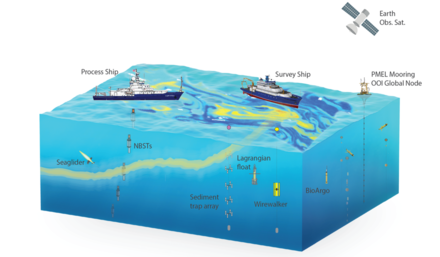Research vessel
This article needs additional citations for verification. (September 2022) |

or interfacing with oceanographic research vessels.[1]
A research vessel (RV or R/V) is a ship or boat designed, modified, or equipped to carry out research at sea. Research vessels carry out a number of roles. Some of these roles can be combined into a single vessel but others require a dedicated vessel. Due to the demanding nature of the work, research vessels may be constructed around an icebreaker hull, allowing them to operate in polar waters.
History
The research ship had origins in the early voyages of exploration.
Some other notable early research vessels were HMS Beagle, RV Calypso, HMS Challenger, USFC Albatross, and the Endurance and Terra Nova.
The names of early research vessels have been used to name later research vessels, as well as Space Shuttles.
Modern types
Hydrographic survey
A hydrographic survey ship is a vessel designed to conduct
Hydrographic survey vessels also conduct
In practice, hydrographic survey vessels are often equipped to perform multiple roles. Some function also as oceanographic research ships. Naval hydrographic survey vessels often do naval research, for example, on submarine detection.
An example of a hydrographic survey vessel is CCGS Frederick G. Creed. For an example of the employment of a survey ship see HMS Hydra.
Oceanographic research
Examples of an oceanographic research vessel include the
Fisheries research
A fisheries research vessel requires platforms capable of towing different types of fishing nets, collecting plankton or water samples from a range of depths, and carrying acoustic fish-finding equipment. Fisheries research vessels are often designed and built along the same lines as a large fishing vessel, but with space given over to laboratories and equipment storage, as opposed to storage of the catch. An example of a fisheries research vessel is FRV Scotia.
Naval research vessels investigate naval concerns, such as submarine and mine detection or sonar and weapons trials. An example of a naval research vessel is the
Polar research
Oil exploration
Oil exploration is performed in a number of ways, one of the most common being mobile drilling platforms or ships that are moved from area to area as needed to drill into the seabed to find out what deposits lie beneath it.
See also
- European and American voyages of scientific exploration
- List of research vessels by country
- Marine research vessels
- Technical research ship
- Weather ship
References
- ^ Just Sit Right Back and You'll Hear a Tale, a Tale of a Plankton Trip NASA Earth Expeditions, 15 August 2018.
- S2CID 254550486.
- ^ Beazley, Charles Raymond (1911). . In Chisholm, Hugh (ed.). Encyclopædia Britannica. Vol. 7 (11th ed.). Cambridge University Press. p. 71.
- ^ Griffin, J.J. (ed) 1991. The Final Report of the Workshop on Scientific Shipboard Diving Safety to the National Science Foundation, University National Oceanographic Laboratory System, Graduate School of Oceanography Technical Report Number 90-04, Narragansett, RI, USA.
- ^ "R/V Cabo de Hornos, Chile". ship-technology.com. Archived from the original on 2 April 2015. Retrieved 28 March 2015.
- ^ RSV Aurora Australis 1989–2020 Australian Antarctic Division, 25 January 2017. Retrieved 26 February 2021.
- ^ About Australia's new icebreaker — RSV Nuyina Australian Antarctic Division, 29 September 2017. Retrieved 26 February 2021.
Further reading
- OCEANIC International Research Vessels Database
- Unofficial (English Language) Homepage of the research icebreaker "ARA Almirante Irizar
- Australian research vessel facilities
- Canadian research fleet
- Alfred Wegener Institute for Polar and Marine Research – home of the "Polarstern"
- Ifremer Fleet
- National Institute of Oceanography and Experimental Geophysics – OGS Trieste ITALY
- NOAA Marine Operations Archived 2007-10-06 at the Wayback Machine
- Scripps Institution of Oceanography Archived 2013-06-07 at the Wayback Machine
- Woods Hole Oceanographic Institution (WHOI) WHOI web page
- University-National Oceanographic Laboratory System (UNOLS) research vessels (US academic fleet)
